If you're tired of watching leads go to contractors who show up first in search results, this ultimate roofing SEO guide will change that. We're not talking about marketing theory or generic SEO advice that doesn't work for roofers. This is a step-by-step blueprint based on what actually gets roofing companies more qualified leads calling their business.
The roofing industry has changed. What used to work isn't working anymore, and being on the 1st page of Google reviewers is a different type of effort. So, in this guide we’ll review SEO strategies for roofing companies:
- How to get found when homeowners search for roofing services in your area
- The exact keywords that bring in qualified leads (not just website visitors)
- Step-by-step local SEO tactics that work specifically for roofing companies
- How to build a website that converts visitors into paying customers
- Real strategies for outranking established competitors
- Whether to handle SEO yourself or hire an agency (and how to choose the right one)
This isn't theory, it's what actually works. By the end of this guide, you'll have a clear action plan to get more qualified roofing leads calling your business. Let's get started.
What Is Roofing SEO & Why It's Different From Everything Else
Roofing SEO isn't just regular search engine optimization with a construction twist. It's a specialized approach that recognizes how people actually search for roofing services and what drives them to pick up the phone.
Think about it: when someone searches "buy shoes online," they might browse for weeks before making a decision. But when they search for "roof leak repair," they need help fast. Their ceiling is dripping, their belongings are getting damaged, and they're stressed about the cost. This urgency completely changes how you need to approach SEO for roofing companies.
Here's What Makes Roofing SEO Unique:
- Emergency-Driven Searches: Most roofing searches happen when there's a problem. "Storm damage repair," "emergency roof leak," and "roof replacement" aren't casual browsing terms. These are people who need a contractor now, which means higher conversion rates but also higher competition for those valuable keywords.
- High-Value Transactions: The average roofing job ranges from $8,000 to $25,000 or more. Compare that to a $50 plumbing service call. Every lead matters more, which means your SEO strategies for roofing companies need to focus on quality over quantity. Getting 10 qualified roofing leads is better than 100 tire-kickers.
- Trust-Critical Industry: Homeowners are inviting strangers onto their roof and into their biggest investment. They read more reviews, check more credentials, and research more thoroughly than almost any other service. Your online presence needs to build trust before they ever call.
- Seasonal Fluctuations: Storm seasons, weather patterns, and seasonal maintenance needs create dramatic swings in search volume. A smart roofing SEO strategy accounts for these patterns and capitalizes on peak periods.
This is why generic SEO advice doesn't work for roofers. The tactics that work for restaurants or retail stores will waste your time and money. You need SEO strategies for roofing companies built specifically for how homeowners search for roofing services and what convinces them to choose one contractor over another.
Roofing SEO Keyword Research: Finding the Terms That Bring in Jobs
Keyword research for roofers isn't about finding the most searched terms, it's about finding the searches that turn into paying customers. A homeowner searching "how much does a roof cost" is in research mode. Someone searching "emergency roof repair [your city]" has their checkbook ready.
Before you start building lists of keywords, you need to understand what different searches actually mean:
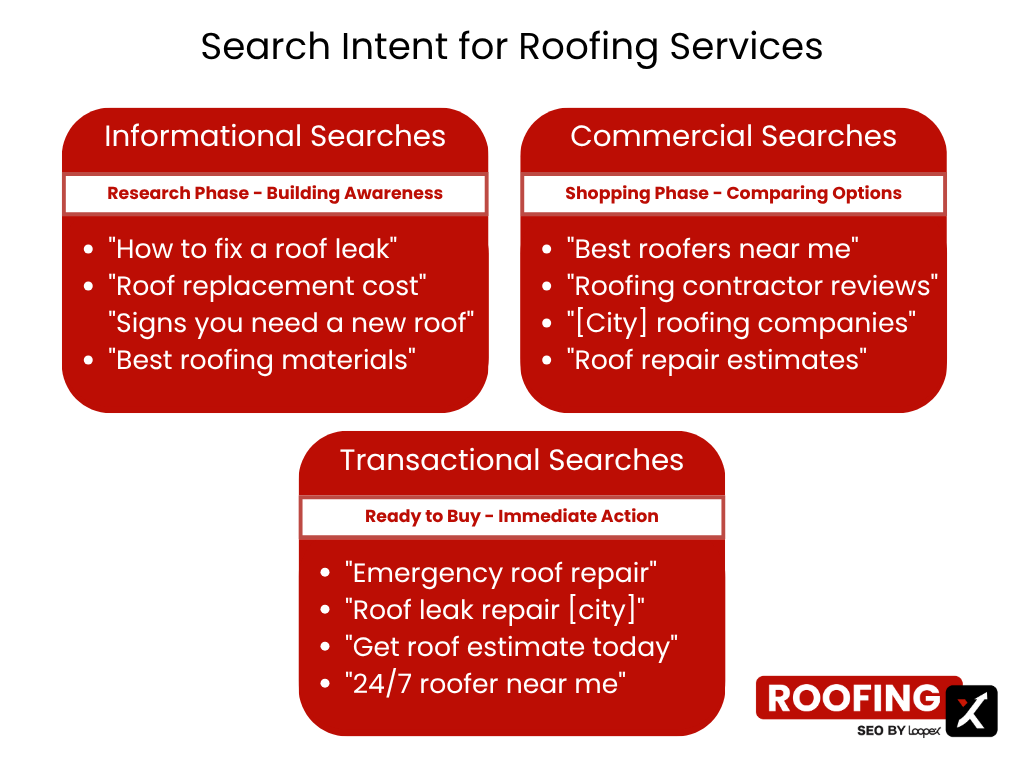
- Informational searches come from homeowners who are learning about their problem. They're valuable for building trust and authority, but they don't convert immediately.
- Commercial searches come from people who’re actively looking for contractors. They're comparing options and getting ready to make calls.
- Transactional searches are your money keywords. People using these terms need help now and are ready to hire someone immediately.
Besides these three, one more search type is important to you as a roofer: local searches. These have geographic angle and combine intent with location, making them extremely valuable for local businesses. Some example are:
- "[City] roofing contractor"
- "Roofers in [county]"
- "[Neighborhood] roof repair"
- "Roofing companies near [landmark]"
Besides these you should pay attention to specific categories, like materials you do roofing repair for, of course, the area. There are two more categories you should definitely consider:

Research Tools and Process
Let’s take a look at some free and paid tools you can use for your keyword research:
Note: These tools can be used for results tracking as well.
Independent of the tool you use, there's a simple process you can follow:
- Start with your main services (repair, replacement, installation)
- Add your location modifiers (city, county, neighborhoods you serve)
- Include problem-specific terms (leak, storm damage, emergency)
- Check what competitors rank for
- Verify local search volume (national numbers don't matter for local businesses)
- Prioritize by intent and competition level
Expert Tip From Our Team: A keyword with 500 monthly searches that brings in 10 qualified leads is more valuable than one with 5,000 searches that brings in zero jobs. Low search volume with high intent beats high volume with low intent every time.
It is essential to find the sweet spot among search volume, competition, and intent.
Your focus should be on the keywords for which homeowners are actively seeking roofing services in your local area, not just looking into roofing in a general sense.
Building a Website That Google (and Customers) Love
Your website is your digital storefront, and for roofing companies, it needs to do two things perfectly: rank well in search results and convert visitors into leads. Most roofing websites fail at both because they're built like brochures instead of lead-generation machines.
Website Structure That Works for Roofers
The way you organize your website directly impacts both your search rankings and your ability to convert visitors. Here's the structure that works best for roofing companies:

Each service and service area then should have a specific and separate service page, like repair, inspection, replacement, installment, etc. As for service areas, make sure to have pages for primary city, secondary city, third city, and county/region. You can include a service area map on your homepage as well to guide the visitors.
Why This Structure Works:
- Each service gets its own dedicated page for better keyword targeting
- Location pages help you rank in multiple cities
- Material pages capture specific product searches
- Clear hierarchy makes it easy for visitors to find what they need
Conversion-Ready Design Elements
Your website needs to turn visitors into leads, not just inform them about roofing. Here are the essential elements:
- "Get Free Estimate" button above the fold on every page
- Click-to-call phone numbers in the header and footer
- Emergency service callouts for urgent situations
- Contact forms on every service and location page
To make sure all this works properly, you should optimize for mobile. 60% of roofing searches happen on mobile devices, often during emergencies:
- Responsive design that works on all screen sizes
- Touch-friendly buttons and phone numbers
- Fast loading times (under 3 seconds)
- Simplified navigation for small screens
- Sticky contact button that follows users as they scroll
Technical Performance Requirements
Potential customers often view your roofing company website as their first introduction to your business. Ensure that it fosters trust, and supplies potential customers with all the requisite info they need to make an easy decision to go ahead and make contact, that is, to reach out to you when they need your services. A clean, fast, mobile-friendly site will outperform a flashy, slow, or hard-to-navigate site hands down.
Let’s move on to the more local sector of our SEO strategies for roofing companies.
Local SEO for Roofing Companies: Dominating Your Service Area
Local SEO is the most important factor for roofing companies. Period. While national brands worry about ranking everywhere, your success depends on showing up when homeowners in your service area search for roofing help. Get local SEO right, and you'll have more qualified leads than you can handle.
Google Business Profile: Your Most Important Asset
Your Google Business Profile (formerly Google My Business) is the foundation of your local SEO success. When someone searches "roofer near me," Google decides which businesses to show based largely on how complete and optimized these profiles are.

Besides those your site needs good quality visual to build trust and provide clarity:
- Your team in action on job sites
- Completed roofing projects (before/after shots)
- Your trucks and equipment
- Your office or shop location
- Team photos showing professionalism
Google Posts is a wonderful way to keep engaging with your audience and not let them forget about you. Posting an update once a week about your business can keep your audience engaged with you and your brand. Used alongside Google My Business, this feature is especially potent, and using it can greatly benefit your SEO. When potential customers are searching for you or competitors, they can see recent updates and have another reason to choose you.
Review Management: The Trust Factor
Reviews are the digital equivalent of word-of-mouth referrals. For roofing companies, they're especially critical because home owners need to trust you with their biggest investment.
Getting More Reviews Systematically:
- Follow-up Email Sequence: Send review requests 3-5 days after job completion
- Text Message Requests: Higher response rate than email for many customers
- In-Person Ask: Request reviews during the final walkthrough
- QR Codes: Include on business cards, invoices, and job site signs
- Website Integration: Add review request on your thank-you pages
Review Response Strategy: Respond to ALL reviews within 24 hours. Even if they are negative, it’s good to get feedback and offer solutions.
Review Management Best Practices:
- Use keywords naturally in responses ("roof repair," "storm damage," your city name)
- Address specific concerns mentioned in negative reviews
- Thank customers for specific details they mention
- Keep responses professional but personal
- Never argue or get defensive in public responses
Local Citations and NAP Consistency
NAP stands for Name, Address, Phone number. Having consistent NAP information across the web tells Google your business is legitimate and helps you rank better in local searches.
Priority Directory Listings:
- Google Business Profile (most important)
- Yelp for Business
- Better Business Bureau
- HomeAdvisor/Angi
- Local Chamber of Commerce
- Nextdoor Business
- Facebook Business Page
- Industry-specific directories (roofing associations)
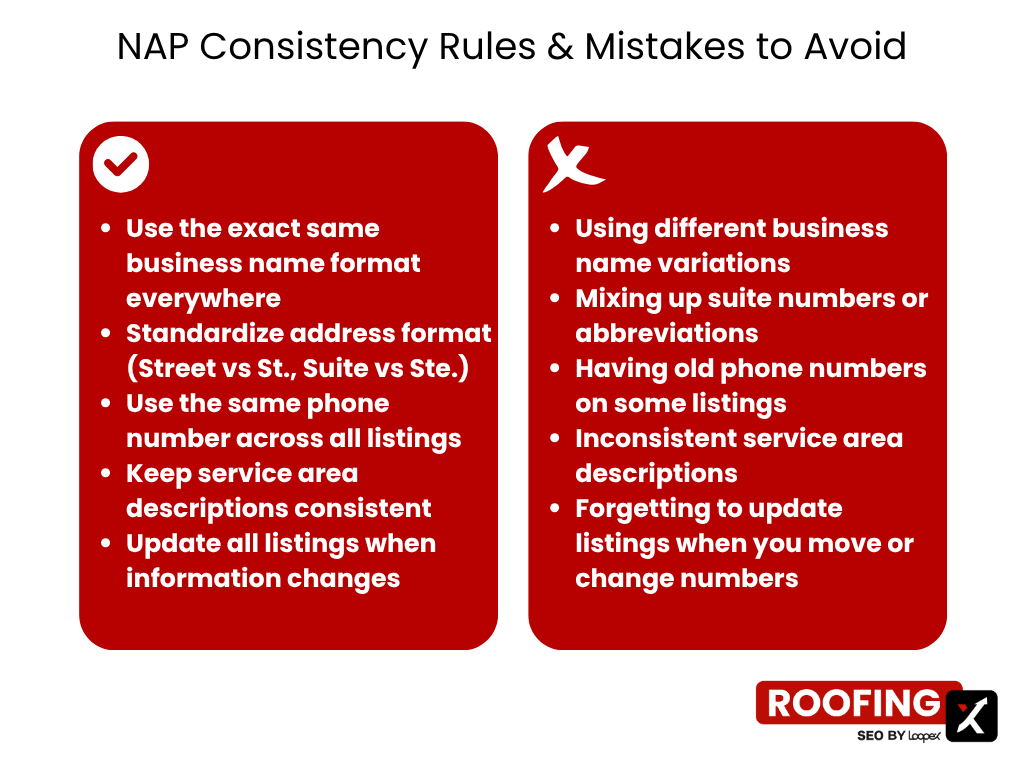
Location-Specific Landing Pages That Rank
If you serve multiple cities, each location needs its own dedicated page. These aren't just for SEO, they help customers understand you actually serve their area.
Location Page Structure:
Title Tag: "[Service] in [City], [State] | [Business Name]"
H1: "Professional [Service] Services in [City], [State]"
Content Requirements for Each Location Page:
- Local Introduction: "We've been serving [City] homeowners since [year]"
- Area-Specific Information: Local weather challenges, common roofing problems
- Service Area Details: Neighborhoods and subdivisions you cover
- Local Testimonials: Reviews from customers in that specific area
- Local Contact Information: If you have multiple offices or service centers
- Driving Directions: How to reach you from that city
- Local Landmarks: References to well-known places in the area
Content That Feels Local, Not Generic: Instead of: "We provide quality roofing services in [City]." Write: "Dallas homeowners know that hail storms can damage roofs in minutes. We've helped over 200 families in the Dallas area recover from storm damage, working directly with insurance companies to make the process as smooth as possible."
Internal Linking for Location Pages:
- Link from your main service pages to relevant location pages
- Connect location pages to each other for nearby cities
- Link to your main contact page and service pages
- Include links to relevant blog posts about local roofing topics
Local Link Building Opportunities
Building relationships in your community creates natural link opportunities that boost your local search rankings.
On-Page SEO Best Practices: Making Every Page Count
Every page on your roofing website is an opportunity to rank for valuable keywords and convert visitors into leads. Don’t let this be the last thing in mind when writing your SEO strategies for roofing companies. On-page SEO ensures Google understands what each page is about and why it should rank for your target keywords.
Title Tags and Meta Descriptions That Get Clicks
Your title tag is the clickable headline that appears in search results. For roofing companies, it needs to include your service, location, and business name while staying under 60 characters.
Title Tag Formula for Service Pages: [Service] in [City], [State] | [Business Name]
Title Tag Best Practices:
- Put your most important keyword first
- Include your location for local searches
- Make it compelling enough to click
- Stay under 60 characters to avoid truncation
- Use your business name for brand recognition
Image Optimization for Roofing Companies
Images are crucial for roofing companies, customers want to see your work. Proper optimization helps these images rank in Google Images and supports your overall SEO.
Technical Image Requirements:
- File Size: Compress images to under 100KB when possible
- File Format: Use WebP for best compression, JPEG for compatibility
- Dimensions: Optimize for your website's display size
- File Names: Use descriptive names with keywords
Alt Text Optimization: Alt text describes images for screen readers and search engines. Include keywords naturally while accurately describing the image.
Image SEO Best Practices:
- Include location data when relevant
- Use before/after photos to show your work quality
- Add captions with additional keyword opportunities
- Create image galleries for different services and materials
- Optimize images for mobile viewing
Schema Markup for Roofing Contractors
Schema markup is code that helps search engines understand your content better. For roofing companies, it can enhance your search listings with additional information. This highly depends on your website hosting provider, but you need to make sure that your listings, reviews, and all pages have schema markups.
URL Structure and Internal Linking
Clean, descriptive URLs help both users and search engines understand your page content.
URL Best Practices:
- Use hyphens, not underscores
- Include target keywords when natural
- Keep URLs short and descriptive
- Avoid unnecessary parameters
- Maintain consistent structure
Simple Content SEO Strategies for Roofing Companies
Let's be honest - most roofing companies think content marketing means throwing up a few blog posts and hoping for the best. But if you want content that actually brings in customers, you need to think like your customers think.
When someone's roof is leaking at 2 AM during a storm, they're not looking for a dissertation on roofing materials. They want to know who can fix their problem fast and do it right. That's where smart content comes in.
Start with Pages That Make Money
Your service pages are where the magic happens. These aren't just informational pages - they're your digital salespeople working 24/7. Think about it: when someone searches "roof repair near me," they're not browsing for fun. They've got a problem and they're ready to spend money to fix it.
Every service you offer needs its own dedicated page. Roof repair, roof replacement, emergency roofing, storm damage restoration - each one should speak directly to someone with that specific problem. Don't just list what you do; explain how you solve their particular headache.
Here's what works: start each page by acknowledging their problem. Maybe their ceiling has water stains and they're panicking about what it'll cost. Address that fear head-on, then walk them through exactly how you'll fix it. Include real photos from jobs you've done - before and after shots are gold. And always, always make it easy for them to contact you.
Content That Builds Trust Over Time
While your service pages handle the ready-to-buy crowd, blog content catches people earlier in their journey. Someone might notice a few loose shingles and start researching before they're ready to call a contractor. That's your chance to be the helpful expert they remember when decision time comes.
The best roofing content answers real questions. Write about the signs that tell a homeowner their roof needs attention. Explain what happens during a professional inspection so they're not nervous about scheduling one. Compare different roofing materials in plain English, not contractor speak.
Seasonal content works particularly well because roofing problems follow weather patterns. Spring brings storm damage and the realization that winter was rough on the roof. Summer means homeowners are planning bigger projects. Fall has everyone thinking about winter prep. Write content that matches what people are worried about each season.
Don't forget about local content either. Every area has its own roofing challenges - whether it's hurricane season, heavy snow loads, or those particular weather patterns that seem to hit your town every year. When you write about local problems with local solutions, you're showing Google and customers that you truly understand their specific situation.
Make Your Content Work Harder
Here's where most roofers mess up: they write a blog post and then forget about it. Smart contractors turn every piece of content into multiple touchpoints. That post about spring roof maintenance becomes social media content for March, goes into your April newsletter, and gets shared again when storm season hits.
Customer success stories are particularly powerful this way. One good case study can become a detailed blog post, a testimonial for your website, several social media posts, and content for your Google Business profile. The key is thinking about how to slice and dice your best content across all your marketing channels.
What Actually Matters
It's essential to monitor what is effective, yet avoid becoming immersed in superficial metrics. Of course, it's pleasurable when a blog entry attains a thousand visits; however, what truly counts is whether those visits convert into telephone inquiries and requests for project estimation.
Pay attention to which pages generate the most contact form submissions. Notice which blog posts lead to the longest time spent on your site - that usually means people are seriously considering your services. And watch your local search rankings because that's where most of your customers will find you.
Technical SEO for Roofing Websites: The Foundation That Supports Everything
Technical SEO is like a house's foundation. If it isn't solid, everything else built on top has problems. For roofing companies, technical issues can mean the difference between page one and page nowhere.
Site Speed and Core Web Vitals
Page speed affects Google search ranking, and for roofing companies, it’s of the utmost importance. When a potential customer discovers that their roof is leaking, they aren’t going to spend even 3 seconds waiting for your website to load, they’ll backtrack and reach out to your nearby competition.
Core Web Vitals Explained:
Largest Contentful Paint (LCP) - How fast your main content loads:
- Target: Under 2.5 seconds
- Common Issues: Large, unoptimized images of roofing projects
- Solutions: Compress images, use WebP format, implement lazy loading
First Input Delay (FID) - How quickly your site responds to user interactions:
- Target: Under 100 milliseconds
- Common Issues: Heavy JavaScript from chat widgets or tracking codes
- Solutions: Minimize JavaScript, defer non-critical scripts
Cumulative Layout Shift (CLS) - How much your page jumps around while loading:
- Target: Under 0.1
- Common Issues: Images without dimensions, ads that load late
- Solutions: Set image dimensions, reserve space for dynamic content
Speed Optimization Strategies for Roofing Sites:
Image Optimization (Critical for roofing sites with lots of project photos):
- Compress images to under 100KB when possible
- Use WebP format for better compression
- Implement lazy loading for gallery images
- Set proper image dimensions in HTML
- Use responsive images for different screen sizes
Hosting and Infrastructure:
- Choose a hosting provider with good performance records
- Use a Content Delivery Network (CDN) to serve images faster
- Enable browser caching for repeat visitors
- Minimize HTTP requests by combining CSS and JavaScript files
Code Optimization:
- Remove unused CSS and JavaScript
- Minify remaining code files
- Defer non-critical JavaScript loading
- Optimize database queries (especially important for WordPress sites)
Mobile Usability: Critical for Emergency Searches
60% of roofing searches happen on mobile devices, often during emergencies. Your mobile experience can make or break your lead generation.
Mobile Optimization Checklist:
Responsive Design Essentials:
- Site adapts to all screen sizes automatically
- Text is readable without zooming (minimum 16px font size)
- Touch targets are at least 44px apart
- Navigation works with thumbs, not just mouse clicks
Mobile-Specific Features:
- Click-to-Call: Phone numbers should be clickable on mobile
- Sticky Contact Button: Keep contact info visible as users scroll
- Simplified Forms: Minimize form fields on mobile
- Fast Loading: Mobile users are even less patient than desktop users
- Easy Navigation: Hamburger menus that actually work
Mobile Testing Process:
- Test on actual devices, not just browser tools
- Check loading speed on 3G connections
- Verify all forms work properly on mobile
- Ensure images display correctly on small screens
- Test the entire customer journey from search to contact
Site Structure and Indexing
To properly rank your pages, Google must comprehend your site structure. Poor site architecture can conceal your finest content from search engines. Your sitemap informs Google which pages matter most, and how frequently they change:
URL Structure Best Practices: Clean URLs help both users and search engines understand your content.
Clean URLs improve both user and search engine experience.
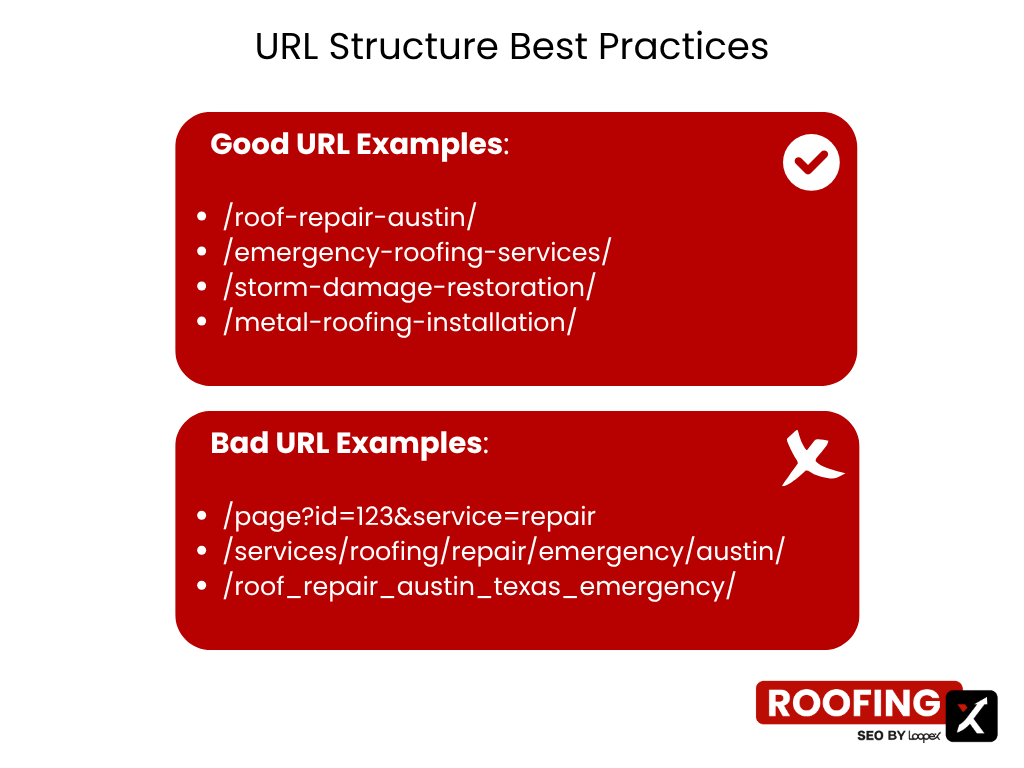
The robots.txt file directs search engines on what to crawl. Essential robots.txt rules you should follow:
- User-agent: *
- Disallow: /admin/
- Disallow: /thank-you/
- Disallow: /wp-admin/
- Allow: /wp-content/uploads/
- Sitemap: https://yoursite.com/sitemap.xml
The foundation that permits all your other SEO endeavors to thrive is laid by technical SEO. A website replete with technical goodness loads rapidly, functions flawlessly on mobile devices, and enables Google to easily comprehend and place a value on your content. Get the technical basics correct (or, at minimum, don't foul them up), and everything else you do becomes more potent.
Link Building for Roofers: The Real Deal
The best links come from places that make sense. Your local Chamber of Commerce, the Better Business Bureau, industry associations, or a local news article about your storm response work - these carry weight because they represent real relationships and community standing.
Google can spot the difference between a link you earned and one you bought. Natural links happen when someone mentions your work, references your expertise, or recommends your services. They fit naturally into the content and come from relevant, established websites.
Avoid these red flags:
- Link farms that exist only to sell links
- Sites completely unrelated to construction or home improvement
- Any offer to buy hundreds of links for cheap
- Private blog networks and other shady schemes
Local Links That Actually Matter
Your best link opportunities are right in your backyard. Every community involvement activity is a potential link opportunity, but more importantly, it's building the local reputation that generates referrals and repeat business.
High-value local opportunities:
- Chamber of Commerce membership and participation
- Sponsoring youth sports teams or community events
- Partnerships with real estate agents and insurance professionals
- Involvement in local business associations
Real estate agents are particularly valuable partners. They constantly work with homeowners who need roof repairs or replacements. Insurance agents deal with storm damage claims and need trusted contractors to recommend. These relationships generate both links and actual business.
Getting Media Attention That Counts
Local media coverage is link building gold, but you can't just send a press release and hope for the best. You need to position yourself as the go-to roofing expert in your area. This is a core part of all successful SEO strategies for roofing companies.
When severe weather hits, local news needs expert commentary. Provide sensible counsel on how to maintain safety while on a roof after a storm. Offer something a little more substantial than the basic, 'don't go up there unless you know it's safe.' Share the insurance claim process with your audience. Help them understand what to expect and what not to expect. Why are you storming again? What is your end goal? Share with your audience effective ways to assess damage from a storm.
Don't wait for disasters. Offer seasonal roofing tips to local media - spring maintenance advice, summer heat damage prevention, fall prep for winter weather. Local newspapers and websites are always looking for helpful content for homeowners.
Industry Connections That Pay Off
Building relationships within the roofing industry creates opportunities for valuable links and business referrals. Join your state roofing association and participate actively. Get involved with the National Roofing Contractors Association if it makes sense for your business.
The relationships with manufacturers can be especially rewarding. Corporations such as GAF, Owens Corning, and CertainTeed frequently showcase certified contractors on their own websites. The links to websites with this kind of content have a lot of clout because they are coming from established authorities in the industry.
Trade publications occasionally need expert commentary or case studies. If you've handled an unusual project or developed an innovative solution, that could become an article that links back to your business.
Creating Content Others Want to Link To
The most sustainable link building happens when you create something so valuable that other websites naturally want to reference it. This takes more effort upfront but generates links over time without constant outreach.
The Right Way to Ask for Links
When you do reach out for links, make it about relationship building, not just link acquisition. If you're contacting a local business, mention specific ways you could help each other. Maybe they occasionally have customers who need roofing work, and you sometimes work with clients who need their services.
For content promotion, focus on why your resource would genuinely help their audience. Don't just ask for a link - explain the value you're offering. A local real estate blog might love to share your storm damage checklist because it helps their readers protect their investment.
Keep outreach personal and local. Generic mass emails get ignored. A personalized message to a local business owner who might actually find your content useful has a much better chance of success.
Tracking Results & Understanding ROI: Measuring What Matters
You can't improve what you don't measure. For roofing companies, tracking the right metrics means the difference between knowing your SEO is working and just hoping it is. The key is focusing on metrics that directly impact your bottom line: leads, calls, and revenue. So let’s see how to track how well SEO strategies for roofing companies worked on you.
Essential Tracking Setup
Google Analytics 4 Configuration: Google Analytics shows you how people find and use your website, but only if it's set up correctly for a roofing business:
- Install GA4 tracking code on every page
- Set up conversion goals for form submissions
- Configure phone call tracking as conversions
- Create custom segments for organic traffic
- Set up enhanced ecommerce if you sell products online
Key Conversions to Track:
- Contact form submissions
- Phone calls from website
- "Get Estimate" button clicks
- Brochure or guide downloads
- Email newsletter signups
Google Search Console Setup: This free tool from Google shows exactly how your site performs in search results. When using this, monitor the following reports:
- Performance Report: Which keywords bring you traffic
- Coverage Report: Which pages Google can and can't find
- Mobile Usability: How well your site works on phones
- Core Web Vitals: Technical performance metrics
- Links Report: Who's linking to your website
Call Tracking Integration: For roofing companies, phone calls are often more valuable than form submissions. Call tracking lets you see which marketing efforts generate calls. With it you can:
- See which keywords generate phone calls
- Track call duration and quality
- Record calls for training purposes
- Attribute phone leads to specific marketing channels
- Calculate true ROI including phone conversions
Key Performance Metrics for Roofing SEO
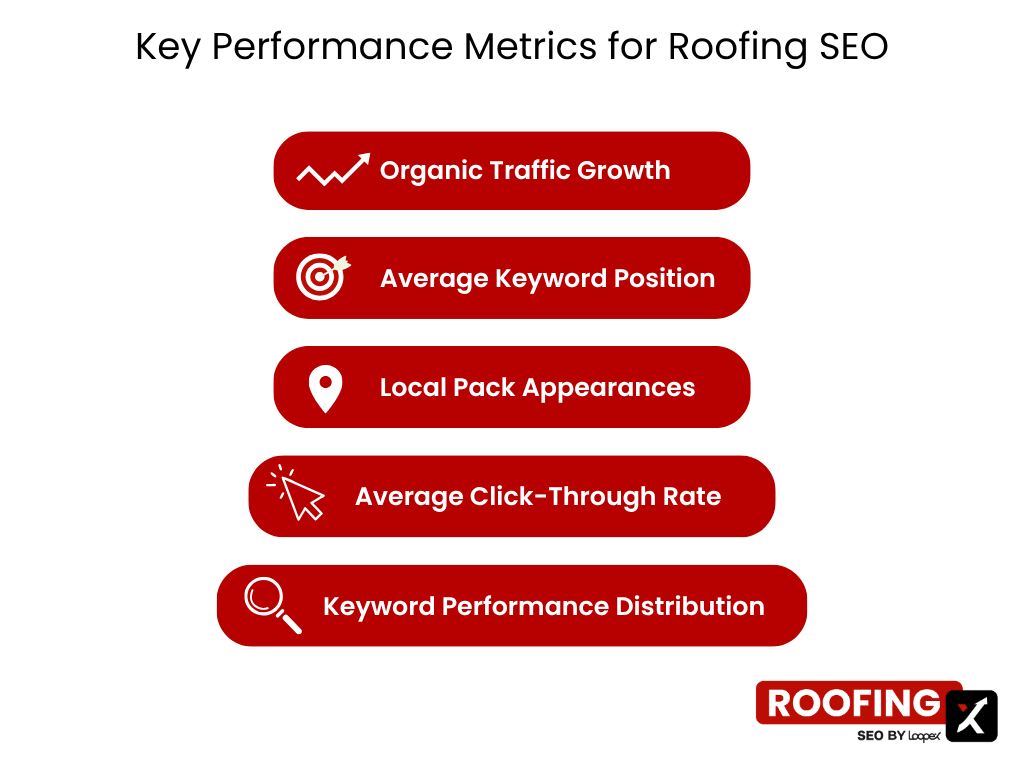
DIY vs Hiring Pros: What's Right for Your Roofing SEO?
Let's talk about the big question every roofer asks: should you handle your roofing SEO yourself or hire someone to do it?
Doing It Yourself
The DIY approach gives you total control and costs way less, maybe $300-500 monthly for tools instead of thousands for an agency. You know your business best, and you can make changes instantly when a storm hits or you add a new service.
But let's be real, effective SEO for roofing companies takes 10-20 hours weekly. That's time not spent on estimates or job sites. Plus, you're facing a steep learning curve, and mistakes can cost you months of progress.
DIY works best for smaller companies with tight budgets or less competitive markets where basic local SEO for roofing companies might be enough to stand out.
Hiring Experts
Working with pros who specialize in SEO strategies for roofing companies means you get expertise from people who've done this dozens of times. They have the expensive tools, keep up with Google's constant changes, and know the technical stuff that most roofers don't have time to learn.
The downside? It'll cost you, think $2,000-8,000 monthly depending on your market. And you're giving up some control, hoping they truly understand what makes roofing customers tick.
Established companies in competitive markets clearly benefit from agency assistance. They can concentrate on roofing, while their experts concentrate on their digital presence.
How you prefer to spend your time, your growth objectives, and your budget all influence which of these two approaches is best for you. No matter what, putting in effort on a consistent basis is what gets you results. That's a true thing for all of us.
Your Success Depends on Taking Action
Let's face it, roofing SEO isn't just a nice-to-have anymore. It's how successful contractors are growing their businesses while others wonder where all the leads went. I've seen firsthand how the right SEO strategies for roofing companies transform companies, bringing in better leads without the per-click costs of paid ads.
SEO isn't a quick fix, so just remember that. The local markets get dominated by the roofing contractors who are in it for a year or more. They focus on small things, like what really moves the needle. They build their dominance from a small but strong foundation.
At this moment, in your service zone, a person is looking for repair work for their roof. Will they discover you or your rival companies? If you want your online visiblity to grow fast, you can get help from a roofing SEO agency.
FAQs
What's the difference between paid ads and SEO for roofers?
Paid ads deliver immediate results with complete messaging control but require ongoing spending ($5-50+ per click) and stop working when you stop paying. SEO takes 3-6 months for significant results but offers higher-quality leads, lower long-term costs, and results that compound over time and continue even with paused efforts. The most successful roofing companies use both: paid ads for immediate leads while building SEO foundation for sustainable growth and better long-term ROI.
Is SEO better than Yelp or HomeAdvisor for getting leads?
SEO offers no per-lead fees, higher trust, long-term compounding value, and better margins compared to paid platforms. HomeAdvisor provides immediate, pre-qualified leads with easy setup but at higher per-lead costs ($300-2,000+ depending on service and market). The most successful roofing companies use SEO as their foundation for long-term growth while supplementing with paid platforms when needed for immediate lead volume.




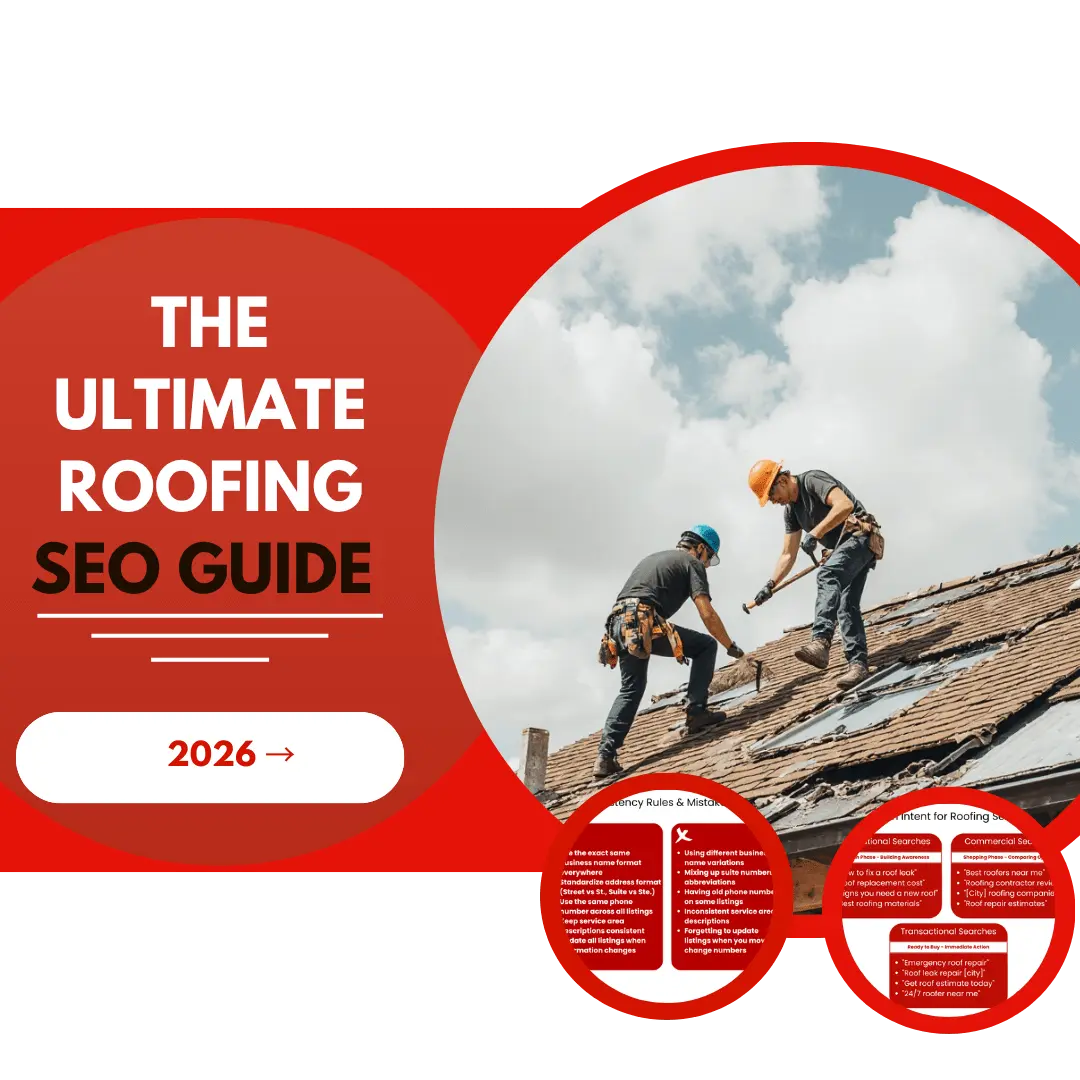

.webp)